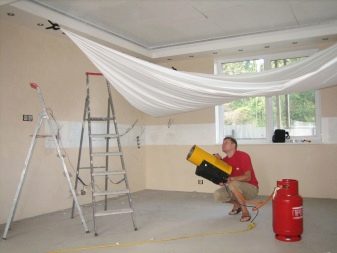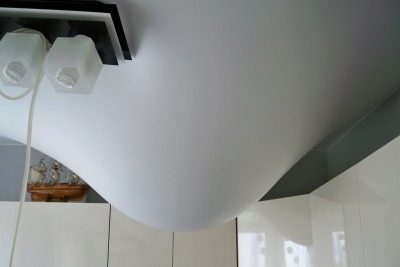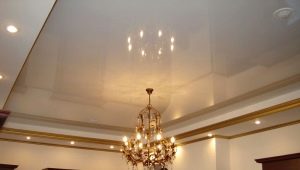Causes of slack tension ceiling
Today, a very popular ceiling finish option is to install a tension cover. Many people who are engaged in repair, prefer this design course. However, despite the fact that the ceiling looks very beautiful, many are embarrassed by the moment that the canvas may sag.
If after performing repairs in the apartment you notice a sagging ceiling, then first of all you need to determine why this happened. It is not necessary to eliminate only defects. Together with them it is necessary to eliminate the causes.
Few people know why this is happening and how to solve the problem. It is this ignorance that often pushes people away from the use of this finishing option and in vain. This article will discuss the main causes of sagging and the methods that can be used to eliminate this situation.
Is there a defect or a norm?
As soon as you install the ceiling, you will surely be blinded by its beauty and will not notice any defects, as it will seem flawless. Over time, when the first impression will not be so bright, during a close inspection of the canvas you will surely notice a small slack. If it does not exceed 1% of the length of the diagonal of the ceiling, there is no cause for concern, since this is the norm and no need to take any action. Physically, the ceiling is not able to have a perfectly flat surface, because the web sags slightly under the influence of its mass. The large area of the canvas causes a stronger difference between the level at the edges and the central part.
Visually, this slack is almost imperceptible. It can only be determined if we consider the canvas along the surface. If the lowering area is more than 1%, then this is a cause for concern.
The reasons
The great advantage of stretch ceilings is that they allow you to get a perfectly smooth surface. Even a slight sagging in this situation adversely affects the appearance of the coating. One should consider the reasons why the ceiling may sag, since there may be many.
- Natural. In this case, the rule referred to earlier is implied. A sag of 1% can be triggered by the difference in temperature in the room with the one that is concentrated in the ceiling ceiling. If ventilation grilles are provided in the ceiling, there will be no sagging for this reason, since the temperature will be equal.
- The second reason for normal sagging is the weight of the web.. As noted earlier, the problem in question is most often encountered in rooms with a large area. It is for this reason that in the spacious rooms the canvas is created from several parts.
- Flooding from above. If the height of the sag is significant, then surely the reason for this is the flooding of the neighbors. In this situation, sagging is not a disadvantage, but becomes its advantage, since the canvas did not allow water to get into the room, ruin the furniture and the flooring. If light-transmitting film-type ceilings were used, then after draining the water, they will very quickly return to their original form.
In such a situation, the level of deflection may be different. In some cases, the ceiling sags almost to the floor, while the canvas is not torn and can withstand a similar load. The level depends on the amount of water that has entered the space between the ceiling surface and the canvas.
If the cause of sagging ceiling was flooding from above, it is not recommended to correct the situation yourself. It is necessary to turn off the electricity in the room and invite a specialist, especially if your ceiling is still under warranty service.
Acting on your own, you can not only spoil the canvas, but also flood your apartment.
To solve this problem, you need special equipment, with which you can quickly drain the water from the ceiling without damaging the canvas itself. Often the volume of water that is concentrated in the ceiling is very large, so it will not be able to fit in a bucket or basin. In addition, the ceiling must be properly dried. If this is not done, spots and stains will remain on its surface.
In some cases, in order to dry the canvas, it is necessary to perform partial dismantling, which should be entrusted to professionals in this field.
There are other reasons for sagging:
- Poor quality material. There are frequent situations when the ceiling is lowered, and this is caused by the use of low-quality materials. This is typical of Chinese products, which are distinguished by their low cost. If we are talking about stretch ceilings, then in this matter it is best not to save money and opt for well-known manufacturers who have already established themselves from the best side. It should be noted that often the price difference between high-quality and low-quality stretch ceilings is insignificant, while you will know for sure that the ceiling will be able to withstand various loads and will be completely safe for your health.
- Profile has moved away from the wall. There are situations when, for any reason, the fastener into which the tensioning sheet is tucked departs from the wall. There is a free flow of air. If you are faced with a similar situation, you should definitely contact the company that installed the ceiling for you, since the cause of this problem is probably related to poor-quality fasteners of the profile to the wall itself. To correct this error, you will need to remove the slack part, re-strengthen the profile and re-tension the coating.
- The presence of defects in the overlap. There are situations when, when preparing the base ceiling, all the whitewash was not removed, which will eventually begin to crumble. This is what provokes further sagging ceiling. Sometimes this happens due to the error of the installers, who have not paid enough attention to the preparation of the ceiling surface. Only professional masters can fix this defect, as it will not work out on their own. To do this, the tension coating is raised and cleaned, the remains of whitewashing and plaster are removed from the main ceiling, after which the canvas is again tensioned.
Remedies
Experts in the field of manufacturing and installation of stretch ceilings are not advised to independently eliminate the problem associated with the slack ceiling. This is due to the fact that a person who does not have the necessary experience is unlikely to be able to perform quality repairs.
Most likely, if you decide to act on your own, then simply spoil the ceiling and it will become unsuitable, therefore, in the future, you will need to buy the canvas again for finishing.
Consider the various situations and methods for solving sagging tension coating.
The room was flooded by the neighbors above
If you notice that the ceiling is starting to sag gradually, then this certainly indicates that it is filling with water. In this situation, you must immediately turn off the electricity, because water is an excellent conductor of electricity, so it is possible to receive an electric shock. If you do not turn off the electricity in time, you can simply spoil the wiring.
In this case, it is quite possible to rectify the situation on your own, since you are only required to drain the water, which is concentrated in the interceiling space. This can be done through openings for spotlights, but only after de-energizing the room. As soon as you get rid of the water, the light-transmitting film ceiling will take on its original appearance, however there are exceptions.
If you have installed a tissue option, then removing water will not help to remove the dark spots formed on the surface. This is due to the fact that water penetrates deep into the fabric, causing it to darken. Eliminate these spots in the future will not work.
To remove the water from the stretch ceiling, you need 2 people. One will pull the canvas to collect the liquid in one section, turning it into a small puddle. The second at this time should be placed in this puddle of a small diameter hose, the end of which should be sent to the bucket. This should be done promptly, which will allow you to quickly normalize the level of humidity in the interceiling space. At the same time, eliminating the problem in a timely manner, you will reduce the risk of mold and mildew.
After the water has been completely drained, the ceiling must be thoroughly heated and dried to prevent stains and stains.
In no case can not pierce the canvas in order to drain water from it. So you only spoil the material, which is no longer subject to repair.
Other cases
Any other reason for slack ceiling requires its dismantling. To fix the problem, the ceiling is removed, the reasons for its deformation are eliminated, and it is again stretched. To do this without the necessary experience and the necessary equipment is almost impossible, so it’s best to turn to professionals.
This is the most reliable way to solve a problem, which reduces the likelihood of error to a minimum.If your ceiling is still under warranty, then eliminating the causes of sagging will also be free. Turning to the experts, you can be sure that the problem will definitely be corrected, and you will again be happy with a smooth and even stretch ceiling.
Tips and tricks
In conclusion, we should once again note some important points.
- Various reasons can provoke a sagging stretch ceiling. This may be flooding from the neighbors from the top, shedding of the old coating, separation of the profile from the wall, or the optimal rate of sagging caused by natural causes.
- Regardless of what the cause of sagging is, you should contact the installers of the web for a solution, since most of the previously mentioned reasons are insured and should be fixed for free.
- If the cause of sagging was flooding from above, then the first step is to turn off the electricity in the apartment. Thus, you can save the performance of the wiring and eliminate the risk of electric shock.
- Most cases require dismantling, which only those who have some experience in this field can cope with, so it’s best to turn to professionals.
Remember that sagging the ceiling is not such a terrible problem if you notice it on time. Flooding the apartment will be much more serious trouble, as it is associated with damage to furniture, flooring and many others, which will lead to serious costs. Stretch ceiling can prevent such situations.
How to independently drain water from the stretch ceiling, see the following video.

















































